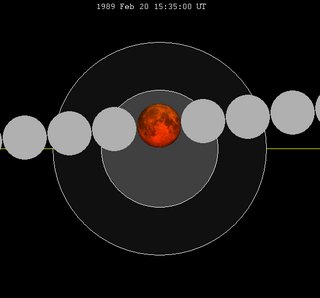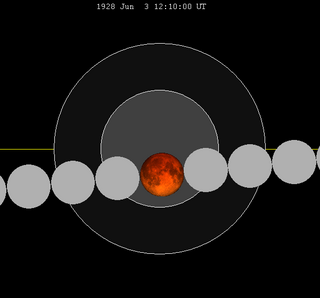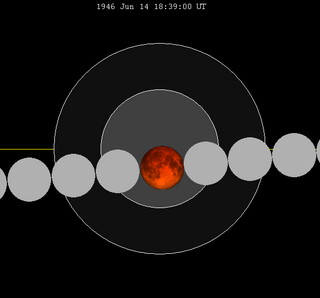
A total lunar eclipse will take place on August 28, 2072.

A total lunar eclipse will take place on August 28, 2072.
It will be completely visible over North America, Europe, Africa, Asia, and Australia, seen rising over Europe, Africa, and Asia and setting over North America. In South America the eclipse will be not visible over invisible.
Lunar saros series 129, repeating every 18 years and 11 days, containing 71 events, has 11 total lunar eclipses. The first total lunar eclipse of this series was on May 24, 1910, and last will be on September 8, 2090. The longest occurrence of this series was on July 16, 2000 when totality lasted 106 minutes and 24.6 seconds.
| Greatest | First | |||
|---|---|---|---|---|
 The greatest eclipse of the series occurred on 2000 Jul 16, lasting 106 minutes. | Penumbral | Partial | Total | Central |
| 1351 Jun 10 | 1513 Sep 15 | 1910 May 24 | 1946 Jun 14 | |
| Last | ||||
| Central | Total | Partial | Penumbral | |
| 2036 Aug 7 | 2090 Sep 8 | 2469 Apr 26 | 2613 Jul 24 | |
| 1910 May 24 | 1928 Jun 3 | 1946 Jun 14 | |||
 |  |  |  |  |  |
| 1964 Jun 25 | 1982 Jul 6 | 2000 Jul 16 | |||
 |  |  |  |  |  |
| 2018 Jul 27 | 2036 Aug 7 | 2054 Aug 18 | |||
 |  |  |  |  |  |
| 2072 Aug 28 | 2090 Sep 8 | ||||
 |  |  |  | ||
It last occurred on August 18, 2054 and will next occur on September 8, 2090.
This is the 40th member of Lunar Saros 129. The previous event was the August 2036 lunar eclipse. The next event is the August 2072 lunar eclipse. Lunar Saros 129 contains 11 total lunar eclipses between 1910 and 2090. Solar Saros 136 interleaves with this lunar saros with an event occurring every 9 years 5 days alternating between each saros series.
A lunar eclipse will be preceded and followed by solar eclipses by 9 years and 5.5 days (a half saros). [1] This lunar eclipse is related to two total solar eclipses of Solar Saros 136.
| August 24, 2063 | September 3, 2081 |
|---|---|
 |  |

A total lunar eclipse took place on Sunday 9 November 2003, the second of two total lunar eclipses in 2003, the first being on 16 May 2003. It is the first total lunar eclipse of 21st century which happened on a micromoon day. The Moon barely edged into total eclipse for 21 minutes and 58 seconds. With the Moon just 1.78% of its diameter into the Earth's umbral shadow, the Moon may have been quite bright, but even so, this should have been worth seeing. The partial eclipse lasted for 3 hours, 31 minutes and 25 seconds. Occurring only 1.4 days before apogee, the Moon's apparent diameter was 6.4% smaller than average.

A total lunar eclipse took place on Tuesday 4 May 2004, the first of two total lunar eclipses in 2004, the second being on 28 October 2004.

A total lunar eclipse took place on Friday, February 9, 1990, the first of two lunar eclipses in 1990.

A total lunar eclipse will take place on Tuesday, March 3, 2026, the first of two lunar eclipses in 2026.

A total lunar eclipse took place on Sunday 16 July 2000, the second of two total lunar eclipses in 2000.

A total lunar eclipse took place on Monday, February 20, 1989, the first of two total lunar eclipses in 1989.

A total lunar eclipse will take place on August 7, 2036. The southern tip of the Moon will pass through the center of the Earth's shadow. This is the last central lunar eclipse of Saros cycle 129.

A total lunar eclipse occurred at the Moon's descending node on 27 July 2018. The Moon passed through the center of Earth's shadow in what was the first central lunar eclipse since 15 June 2011. It was also the second total lunar eclipse in 2018, after the one on 31 January. It was the longest total lunar eclipse of the 21st century, but not the longest in the 3rd millennium. The longest total lunar eclipse of the 3rd millennium will occur on May 12, 2264, lasting 106 minutes and 13.2 seconds, which will be the longest total lunar eclipse since 2000, and the longest one until 3107.
A total lunar eclipse took place on Tuesday, July 6, 1982, the second of three total lunar eclipses in 1982, and the only one that was in the descending node. A dramatic total eclipse lasting 1 hour and 46 minutes plunged the full Moon into deep darkness, as it passed right through the centre of the Earth's umbral shadow. While the visual effect of a total eclipse is variable, the Moon may have been stained a deep orange or red colour at maximum eclipse. This was a great spectacle for everyone who saw it. The partial eclipse lasted for 3 hours and 56 minutes in total.

A total lunar eclipse took place on Thursday, June 25, 1964. The Moon passed through the center of the Earth's shadow.

A partial lunar eclipse occurred on 19 November 2021. The eclipse occurred towards a micromoon. This was the longest partial lunar eclipse since 18 February 1440, and the longest until 8 February, 2669; however, many eclipses, including the November 2022 lunar eclipse, have a longer period of umbral contact at next to 3 hours 40 minutes. It was often referred to as a "Beaver Blood Moon" although not technically fulfilling the criteria for a true blood moon (totality).

A total lunar eclipse will take place on 7-8 September 2025. The Moon will barely miss the center of the Earth's shadow. It will be the second of two total lunar eclipses. Occurring roughly 3 days before perigee, the Moon will appear larger than usual.
A penumbral lunar eclipse took place on Saturday, November 6, 1976, the second of two lunar eclipses in 1976, the first being on May 13. This subtle penumbral eclipse may have been visible to a skilled observer at maximum eclipse. 83.827% of the Moon's disc was partially shaded by the Earth, which caused a gentle shadow gradient across its disc at maximum; the eclipse as a whole lasted 4 hours, 25 minutes and 52.1 seconds. Occurring only 0.3 days after apogee, the Moon's apparent diameter was 6.5% smaller than average.

A total lunar eclipse took place on Wednesday, October 18, 1967, the second of two total lunar eclipses in 1967, the first being on April 24, 1967.
A total lunar eclipse took place at the Moon's descending node of the orbit on Tuesday, May 24, 1910 with an umbral eclipse magnitude of 1.09503. A total lunar eclipse takes place when the Earth comes between the Sun and the Moon and its shadow covers the Moon. Eclipse watchers can see the Moon turn red when the eclipse reaches totality. Total eclipses of the Moon happen at Full Moon when the Sun, Earth, and Moon are aligned to form a line. The astronomical term for this type of alignment is syzygy, which comes from the Greek word for being paired together. The Moon does not have its own light but shines because its surface reflects the Sun's rays. During a total lunar eclipse, the Earth comes between the Sun and the Moon and blocks any direct sunlight from reaching the Moon. The Sun casts the Earth's shadow on the Moon's surface. A shallow total eclipse saw the Moon in relative darkness for 49 minutes and 29.5 seconds. The Moon was 9.503% of its diameter into the Earth's umbral shadow, and should have been significantly darkened. The partial eclipse lasted for 3 hours, 35 minutes and 22.9 seconds in total.

A total lunar eclipse took place on Sunday, June 3, 1928.

A total lunar eclipse took place on Friday, June 14, 1946. The northern tip of the moon passed through the center of the Earth's shadow. This was the first central lunar eclipse of Saros series 129.

A total lunar eclipse will take place on August 18, 2054.

A total lunar eclipse will take place on September 8, 2090.

Saros cycle series 129 for lunar eclipses occurs at the moon's descending node, repeats every 18 years 11+1/3 days. The 129th lunar saros is associated with Solar Saros 136.